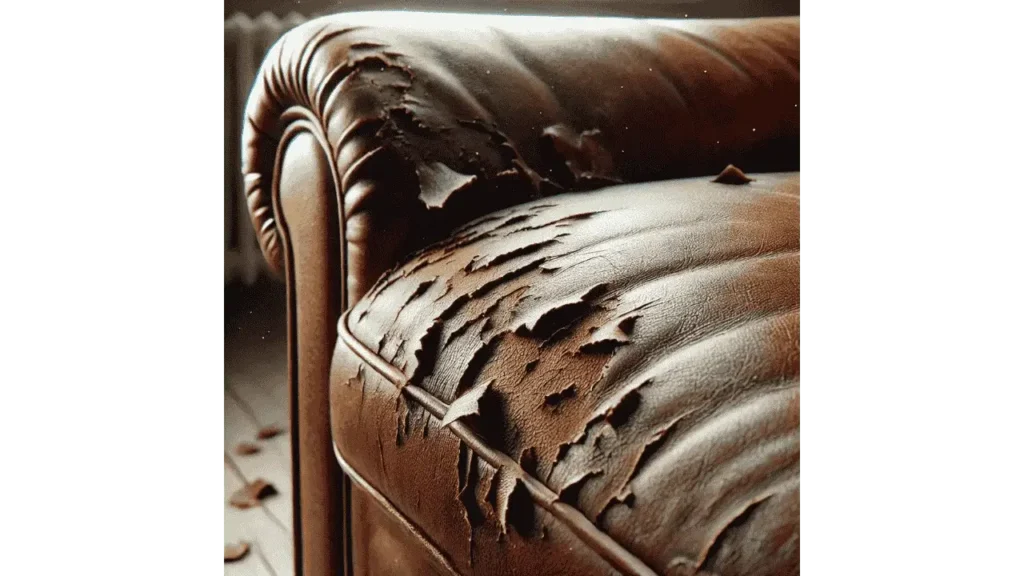Noticing peeling on a leather couch can be frustrating, especially when you’ve invested in what you believed to be a durable and stylish piece of furniture. Understanding the reasons behind the peeling can help in taking the right measures to prevent further damage and restore the couch’s appearance.

Common Causes of Leather Couch Peeling
Several factors contribute to leather couch peeling, and identifying the underlying cause is the first step in addressing the issue effectively.
Low-Quality or Bonded Leather
Many couches labeled as leather are made from bonded leather, which consists of scraps and fibers pressed together with adhesives. Over time, the surface layer of bonded leather tends to peel, revealing the fabric backing underneath. Unlike genuine leather, bonded leather lacks the strength and longevity to withstand regular use.
Lack of Proper Maintenance
Leather requires consistent care to stay in good condition. Without regular cleaning and conditioning, the leather can dry out, leading to peeling and cracking. Dust, dirt, and body oils can also accumulate, causing the surface to deteriorate over time.
Exposure to Sunlight and Heat
Placing a leather couch in direct sunlight or near heat sources can cause it to lose moisture, leading to peeling and fading. Prolonged exposure can dry out the natural oils in the leather, making it brittle and more prone to damage.
Use of Harsh Cleaning Products
Using cleaning products that contain alcohol, bleach, or ammonia can strip the leather of its natural protective coating. These harsh chemicals weaken the leather fibers, making them more susceptible to peeling and cracking.
Normal Wear and Tear
Everyday use, including sitting, reclining, and movement, can gradually wear down the protective coating on the leather. Over time, areas that experience frequent contact may begin to show signs of peeling, especially if the leather is not well-maintained.
Read More: How to Get Smoke Out of a Leather Couch?
How to Prevent Leather Couch Peeling?
Taking preventive measures can help maintain the appearance and durability of a leather couch, ensuring it remains in good condition for an extended period.
Regular Cleaning and Conditioning
Cleaning the leather with a damp cloth and applying a suitable conditioner helps to keep it hydrated and supple. Conditioning helps replenish the natural oils that protect the surface from drying and peeling.
Avoiding Direct Sunlight
Positioning the couch away from windows and heat sources can prevent premature aging and drying. Using curtains or blinds can help minimize exposure to sunlight, protecting the leather from UV damage.
Using Proper Cleaning Products
Selecting gentle, leather-safe cleaning products ensures that the protective coating remains intact. Avoiding harsh chemicals and opting for pH-balanced cleaners designed specifically for leather can prolong its life.
Learn More: How to Clean a Faux Leather Couch?
Maintaining Optimal Humidity Levels
Keeping indoor humidity levels balanced helps prevent the leather from drying out. Using a humidifier during dry seasons can add moisture to the air, reducing the risk of peeling.
Repairing Peeling Leather Couch
If peeling has already started, there are ways to restore the couch and prevent further damage.
Assessing the Extent of the Damage
Before attempting repairs, it’s essential to assess how severe the peeling is. Minor peeling can often be fixed with DIY solutions, while extensive damage may require professional intervention.
Using Leather Repair Kits
Leather repair kits contain fillers, adhesives, and color-matching solutions that can help restore the couch’s appearance. These kits provide a temporary fix and work best for minor peeling issues.
Professional Repair Services
For severe peeling or widespread damage, seeking professional repair services can ensure a long-lasting solution. Leather specialists have the expertise and tools to restore the couch effectively.
How to Differentiate Between Real and Fake Leather?
Understanding whether a couch is made of real or synthetic leather can help in choosing the right care methods and prevent future peeling issues.
Texture and Grain Inspection
Real leather has a unique, irregular grain pattern with natural imperfections, while synthetic leather often has a uniform, artificial look. Running fingers over the surface can help identify real leather’s distinct texture.
Water Absorption Test
Applying a few drops of water to the leather can help determine its authenticity. Real leather absorbs water slowly, while synthetic leather repels it and causes droplets to sit on the surface.
Smell and Feel
Genuine leather has a distinct, rich smell that synthetic materials cannot replicate. Additionally, real leather feels soft and pliable, whereas fake leather often feels plasticky and rigid.
Conclusion
Peeling leather couches can be caused by factors such as low-quality materials, lack of maintenance, and exposure to heat or sunlight. By understanding the causes and taking proactive measures like regular cleaning, conditioning, and protecting the couch from environmental factors, you can prevent further damage. If peeling has already started, assessing the extent and choosing the appropriate repair solution can help restore the couch’s appearance and functionality.
- How to Wear an Oversized Leather Jacket? Style Tips for a Casual Look - August 6, 2025
- How to Fold a Leather Jacket? - August 5, 2025
- How Should a Leather Jacket Fit a Woman? - August 1, 2025



